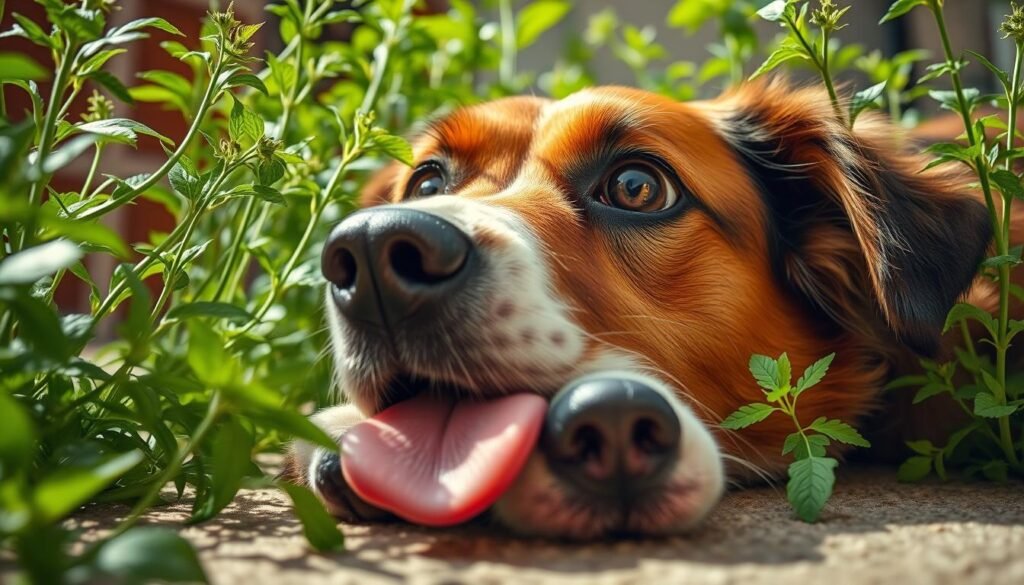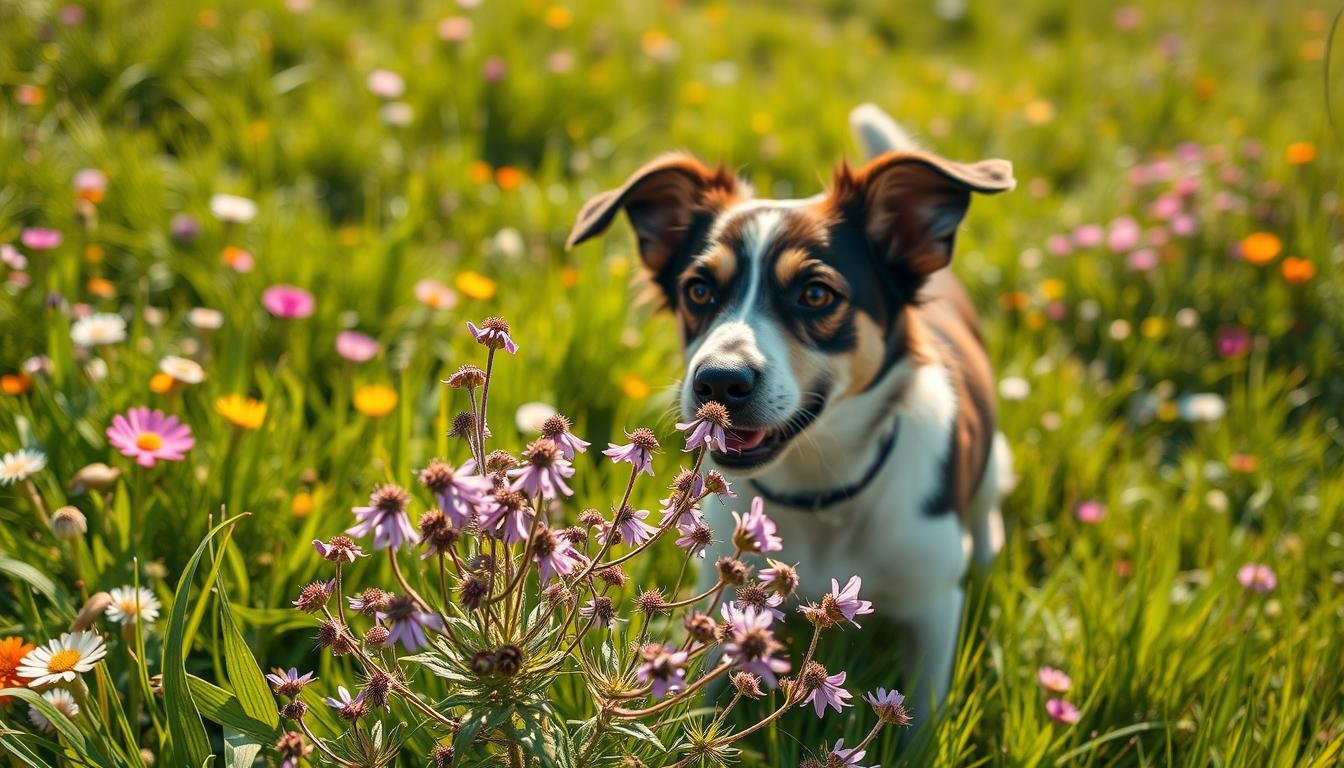Many pet owners wonder, “Can dogs eat catnip?” This herb, known for its stimulating effect on cats, has a different impact on other animals. Contrary to popular belief, catnip is safe and non-toxic for dogs. In fact, it may even offer some surprising benefits.
While catnip excites felines, it often has a calming effect on dogs. Scientific studies and veterinarians confirm its safety, making it a viable option for pet owners. This article explores the origins, nutritional benefits, and behavioral effects of catnip for dogs. You’ll also find practical tips on how to use it safely.
Backed by trusted web sources and expert opinions, this guide provides clear, factual insights. Whether you’re curious about its calming properties or its potential health benefits, we’ve got you covered.
Key Takeaways
- Catnip is safe and non-toxic for dogs.
- It often has a calming effect, unlike its stimulating impact on cats.
- Scientific insights and veterinarian recommendations support its use.
- Catnip may help with mild anxiety or stress in dogs.
- Monitor your pet’s reaction to ensure it’s beneficial.
Understanding Catnip: Origins and Nutritional Benefits
Known for its unique effects on cats, catnip is more than just a feline favorite. This aromatic herb, scientifically named Nepeta cataria, belongs to the mint family. Its distinctive scent and properties have made it a popular choice for both pets and humans.
What is Catnip?
Catnip is a perennial plant with heart-shaped leaves and small white or lavender flowers. Its strong aroma comes from the essential oil nepetalactone, which is the primary active ingredient. Historically, this herb has been used in traditional medicine for its calming and digestive benefits.
Nutritional Profile and Key Ingredients
Catnip is rich in nutrients that contribute to its health benefits. It contains magnesium, vitamins C and E, tannins, and flavonoids. These components support digestive health and offer mild antiseptic properties. The essential oil in catnip also plays a role in its calming effects.
For more insights on how catnip affects pets, explore this detailed guide.
Whether fresh or dried, catnip provides a range of benefits that make it a versatile addition to any pet owner’s toolkit. Its natural properties set the stage for its varied effects on different animals.
How Catnip Affects Dogs Versus Cats

The effects of catnip on pets vary significantly between species. While it’s widely known for its stimulating effect on felines, its impact on other animals, particularly dogs, is quite different. Understanding these differences can help pet owners make informed decisions about its use.
Different Behavioral Reactions
Cats often exhibit euphoric behaviors when exposed to catnip. They may roll, rub, or become hyperactive. This is due to the chemical nepetalactone, which binds to receptors in their vomeronasal organ.
In contrast, dogs typically experience a calming effect. Instead of hyperactivity, they may become relaxed or show quiet interest. This mild sedative reaction is backed by scientific research and is a key difference between the two species.
Scientific Insights on Nepetalactone
Nepetalactone, the active compound in catnip, plays a central role in these differing reactions. In cats, it triggers a euphoric response by stimulating sensory neurons. However, in dogs, it has a minimal binding affinity, leading to a more subdued effect.
Studies suggest that only a small percentage of dogs react to catnip, and even then, the response is often mild. This stark contrast highlights the unique ways animals interact with this versatile plant.
| Species | Behavioral Reaction | Scientific Explanation |
|---|---|---|
| Cats | Euphoria, hyperactivity | Nepetalactone binds to receptors, causing stimulation. |
| Dogs | Calmness, mild sedation | Minimal receptor binding, leading to a subdued effect. |
Can Dogs Eat Catnip Safely?

Understanding the safety of catnip for dogs is essential for responsible pet care. While it’s widely known for its effects on cats, its impact on other animals, particularly dogs, is different. Web sources confirm that catnip is non-toxic and safe when given in appropriate amounts.
Safe Dosage and Forms
When introducing catnip to your pup, it’s crucial to follow dosage guidelines. A small amount, such as 1/8 to 1/2 teaspoon sprinkled on food, is typically sufficient. Dried catnip is the most common form, but catnip-infused essential oil can also be used in very low quantities.
Catnip’s mild sedative effect can help calm anxious dogs without altering their normal behavior. However, excessive consumption may lead to gastrointestinal upset. Always monitor your pet’s reaction and adjust the form and amount accordingly.
Veterinarian Recommendations
Consulting a veterinarian is always recommended before adding new herbs to your dog’s routine. Experts endorse the cautious use of catnip for its calming properties, especially for anxious pups. According to Healthy Paws Pet Insurance, catnip is safe and non-toxic for dogs, acting as a sedative rather than a stimulant.
Veterinarians also emphasize the importance of ensuring dog health by monitoring for any adverse reactions. Persistent symptoms like vomiting or diarrhea require immediate attention. By following expert advice, you can safely incorporate catnip into your dog’s routine.
| Form | Recommended Amount | Purpose |
|---|---|---|
| Dried Catnip | 1/8 to 1/2 teaspoon | Calming effect |
| Essential Oil | Very low quantities | Mild sedation |
Practical Ways to Incorporate Catnip into Your Dog’s Routine
Incorporating catnip into your dog’s routine can be simple and beneficial. This versatile herb offers a natural way to support your pup’s well-being. Whether you’re looking to calm anxiety or add enrichment, catnip can be a helpful ingredient in your pet care toolkit.
Using Catnip as a Calming Aid
Catnip’s mild sedative properties make it an excellent choice for calming your dog in stressful situations. Before events like vet visits or fireworks, sprinkle a small amount of dried catnip on their food or bedding. This can help ease anxiety and promote relaxation.
For a quick calming effect, try rubbing a few fresh catnip leaves between your fingers and letting your pup sniff them. This method works well for on-the-go situations and takes just a minute to prepare.
Tips on Mixing Catnip with Food or Water
Adding catnip to your dog’s meals is an easy way to introduce its benefits. Mix 1/8 to 1/2 teaspoon of dried catnip into their food. This small amount is enough to provide a calming effect without overwhelming their system.
For a refreshing twist, steep a few catnip leaves in water and let it cool. Offer this infused water to your dog during hot weather or after exercise. It’s a hydrating way to incorporate this herb into their routine.
Remember, moderation is key. Always monitor your dog’s reaction and consult your veterinarian if you have any concerns.
Potential Risks and Considerations for Pet Owners
Pet owners often question the safety of catnip for their furry companions. While it’s generally safe, there are potential risks to be aware of. Understanding these can help ensure a positive experience for your dog.
Understanding Possible Side Effects
Excessive consumption of catnip may lead to mild stomach upset, such as vomiting or diarrhea. Every pet reacts differently, with some showing no reaction and others being more sensitive. Monitoring your dog closely after introducing catnip is essential.
Signs of overuse include lethargy or unusual behavior. While catnip is a natural supplement, it’s important to use it in moderation. Overdoing it can negate its calming effect and cause discomfort.
When to Consult a Veterinarian
If your dog shows persistent symptoms like prolonged stomach issues or signs of distress, consult a veterinarian. This is especially important if your pet is on medication, as catnip may interact with certain drugs.
During stressful situations, such as travel or loud events, catnip can be a helpful tool. However, always observe your dog’s reaction and adjust the amount as needed. Responsible use ensures your dog’s health remains a top priority.
Conclusion
Catnip, often associated with its stimulating effect on felines, offers a different experience for other animals. For dogs, this plant is safe and non-toxic, providing a natural way to ease anxiety and promote calmness. Scientific research highlights how the active compound, nepetalactone, has a minimal effect on dogs, contrasting sharply with its impact on cats.
When used correctly, catnip can be a helpful benefit for your pet. Whether sprinkled on food or infused in water, it’s a versatile addition to their routine. Always start with a small amount and monitor their reaction to ensure it’s beneficial.
Consulting a veterinarian is crucial, especially in stressful situations. With proper guidance, catnip can support your dog’s overall well-being. Responsible use ensures it remains a safe and effective supplement for your furry friend.




Interesting read, but does catnip affect different dog breeds differently? Would be great to see breed-specific reactions detailed.
Interesting read! But, arent there specific dog-friendly alternatives than resorting to catnip? Lets keep species-specific treats, guys!
Interesting read. But, do dogs exhibit the same behavior as cats when they consume catnip? Just curious.